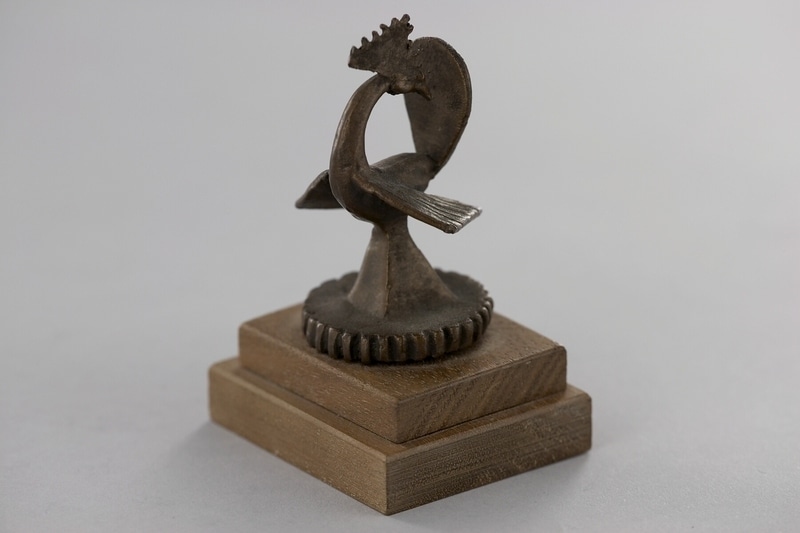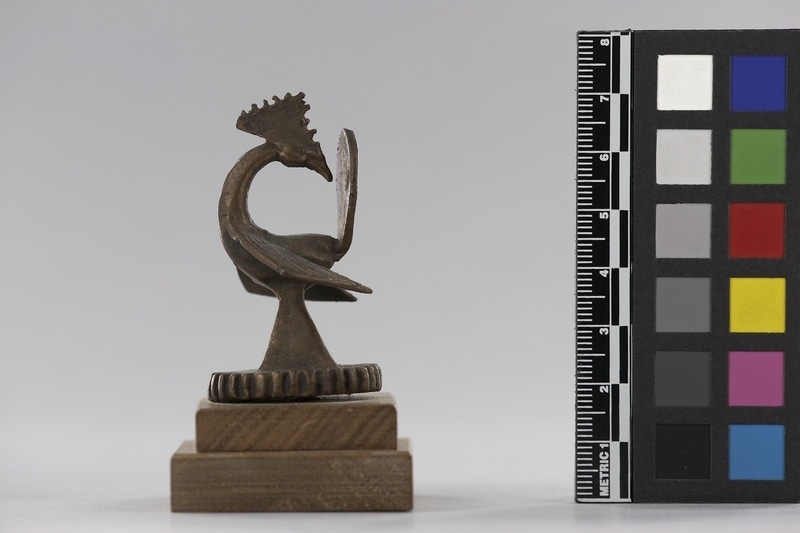Replica Weight Item Number: K2.94 from the MOA: University of British Columbia


Description
Replica gold weight in the form of a cast bronze bird attached to a wood base. The bird is a rooster with its head turned backward toward its flat, upward pointing tail that is perpendicular to the bird's beak. The triangular wings that have incised lines are open and pointing slightly downward at either side. On a pyramidal shape with a circular pedestal that is vertically grooved around the edges. The figure is attached to a square, stepped wooden base.
History Of Use
Akan gold weights were used to weigh powdered gold (gold dust), the standard currency of the Asante Empire from the 17th to the mid-19th centuries. Locally referred to as abrammuo (singular mrammuo), these weights were usually made of a brass alloy. The figures were cast using the lost-wax technique, and range in form from simple geometric designs (thought to be the earliest forms) to figurative forms such as animals and humans or items such as swords and Adinkra symbols.
Cultural Context
Reproduction of an Akan/Asante gold weight out of cast bronze.
Narrative
Purchased (along with K2.95, K2.96 and K2.97) as a reproduction, from a Vancouver store that specialized in art reproductions. The label on the base of K2.96 says "Authentic copyrighted reproduction made from the original at the Art Institute of Chicago, Chicago Ill." They were acquired by MOA curator Audrey Hawthorn, who valued the educational potential of items, even if they were reproductions. But as commercially produced 'copyrighted reproductions' the pieces also represent a contemporary coloniality, in that the individual authorship of an Asante artist has been replaced with an American museum as the proprietor of the design.
Item History
- Made in Chicago, Illinois, USA during 1968
- Owned by Museum Art before September 1968
- Received from Leon & Thea Koerner Foundation (Funding source) and Museum Art (Seller) during September 1968
What
- Name
- Replica Weight
- Identification Number
- K2.94
- Type of Item
- weight
- Material
- wood and bronze metal
- Manufacturing Technique
- cast
- Overall
- height 7.4 cm, width 4.7 cm, depth 4.1 cm
Who
- Culture
- Akan and Asante
- Previous Owner
- Museum Art
- Received from
- Leon & Thea Koerner Foundation (Funding source) and Museum Art (Seller)
Where
- Holding Institution
- MOA: University of British Columbia
- Made in
- Chicago, Illinois, USA
When
- Creation Date
- during 1968
- Ownership Date
- before September 1968
- Acquisition Date
- during September 1968
Other
- Item Classes
- metalwork
- Condition
- good
- Current Location
- Case 101
- Accession Number
- 0143/0008